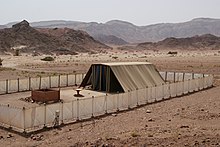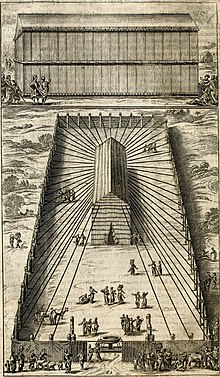
Back مشكن Arabic خيمة الاجتماع ARZ Tabernakel BAR Скиния Bulgarian Tabernacle Catalan Stan setkávání Czech Tabernaklet Danish Mischkan German Σκηνή του Μαρτυρίου Greek Tabernáculo Spanish


According to the Hebrew Bible, the tabernacle (Hebrew: מִשְׁכַּן, romanized: miškan, lit. 'residence, dwelling place'), also known as the Tent of the Congregation (Hebrew: אֹהֶל מוֹעֵד, romanized: ʔōhel mōʕēḏ, also Tent of Meeting), was the portable earthly dwelling used by the Israelites from the Exodus until the conquest of Canaan. Moses was instructed at Mount Sinai to construct and transport the tabernacle[1] with the Israelites on their journey through the wilderness and their subsequent conquest of the Promised Land. After 440 years, Solomon's Temple in Jerusalem superseded it as the dwelling-place of God.
The main source describing the tabernacle is the biblical Book of Exodus, specifically Exodus 25–31 and 35–40. Those passages describe an inner sanctuary, the Holy of Holies, created by the veil suspended by four pillars. This sanctuary contained the Ark of the Covenant, with its cherubim-covered mercy seat. An outer sanctuary (the "Holy Place") contained a gold lamp-stand or candlestick. On the north side stood a table, on which lay the showbread. On the south side was the Menorah, holding seven oil lamps to give light. On the west side, just before the veil, was the golden altar of incense.[2] It was constructed of 4 woven layers of curtains and 48 15-foot tall standing wood boards overlaid in gold and held in place by its bars and silver sockets and was richly furnished with valuable materials taken from Egypt at God's command.
- ^ Numbers 4:1–35.
- ^ Cite error: The named reference
ODCC selfwas invoked but never defined (see the help page).
© MMXXIII Rich X Search. We shall prevail. All rights reserved. Rich X Search